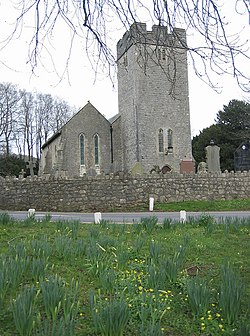St Fagans: Difference between revisions
Created page with '{{Infobox town |name=St Fagans |welsh=Sain Fagan |county=Glamorgan |picture=St Fagans-St Marys Church.jpg |picture caption=St Mary's, St Fagans |os grid ref=ST117771 |latitude=51…' |
mNo edit summary |
||
| Line 18: | Line 18: | ||
In 1648, the Battle of St Fagans took place close by. | In 1648, the Battle of St Fagans took place close by. | ||
To the south lies the village of [[Michaelston-super-Ely]], and to the east the Cardiff suburb of [[Fairwater, Glamorgan|Fairwater]]. There was once a railway station in the village, and the | To the south lies the village of [[Michaelston-super-Ely]], and to the east the Cardiff suburb of [[Fairwater, Glamorgan|Fairwater]]. There was once a railway station in the village, and the South Wales Main Line still runs through | ||
The parish church is St Mary's. St Fagans Old Rectory is a notable building in the village. | The parish church is St Mary's. St Fagans Old Rectory is a notable building in the village. | ||
Latest revision as of 17:04, 15 August 2012
| St Fagans Welsh: Sain Fagan | |
| Glamorgan | |
|---|---|
 St Mary's, St Fagans | |
| Location | |
| Grid reference: | ST117771 |
| Location: | 51°29’9"N, 3°16’23"W |
| Data | |
| Post town: | Cardiff |
| Dialling code: | 029 |
| Local Government | |
| Council: | Cardiff |
| Parliamentary constituency: |
Cardiff West |
St Fagans is a village in Glamorgan, lying to the west of Cardiff. The village stands on the River Ely. St Fagans is best known for the St Fagans National History Museum (formerly called the Museum of Welsh Life).
In 1648, the Battle of St Fagans took place close by.
To the south lies the village of Michaelston-super-Ely, and to the east the Cardiff suburb of Fairwater. There was once a railway station in the village, and the South Wales Main Line still runs through
The parish church is St Mary's. St Fagans Old Rectory is a notable building in the village.
St Fagans Castle and the St Fagans National History Museum

St Fagans National History Museum (Welsh: Sain Ffagan: Amgueddfa Werin Cymru), commonly referred to as St Fagans after the village, is an open-air museum at St Fagans displaying the historical lifestyle, culture and architecture of the Welsh people. The museum is part of the National Museum Wales.
The museum comprises over thirty re-erected buildings from various locations in Wales, and is set in the grounds of St Fagans Castle, an Elizabethan manor house. In 2011 Which? magazine named the museum the United Kingdom's favourite visitor attraction.[1]
The museum was started in 1946 following the donation of the castle and lands by the Earl of Plymouth. It opened its doors to the public in 1948, under the name of the Welsh Folk Museum. The museum's name in Welsh (also meaning "Welsh Folk Museum") has remained unchanged since that date, while the English title has been modified once to Museum of Welsh Life, and again to its current name.
The brainchild of Iorwerth Peate, the museum was modelled on Skansen, the outdoor museum of vernacular Swedish architecture in Stockholm. Most structures re-erected in Skansen were built of wood and are thus easily taken apart and reassembled, but a comparable museum in Wales was naturally going to be more ambitious as much of the vernacular architecture of Wales is made of masonry. The same model has been imitated at the Chiltern Open Air Museum in Chalfont St Peter, Buckinghamshire, though the latter is far smaller than what has been achieved at St Fagans.
Buildings and exhibits
The museum includes over forty buildings which represent the architecture of Wales, with farmhousesd of various ages, a mediaeval church, a Unitarian chapel, a village schoolhouse, a toll house, a cockpit, a pigsty and a tannery. St Fagans Castle, form whose estate the museum was built, stands at one end of the site and forms part of the museum also.
The museum holds displays of traditional crafts with a working blacksmith's forge, a pottery, a weaver, miller and clog maker. It also includes two working water mills: one flour mill and one wool mill. Part of the site includes a small working farm which concentrates on preserving local Welsh native breeds of livestock. Produce from the museum's bakery and flour mill is available for sale.
The mediaeval parish church of St Teilo (below) formerly at Llandeilo Tal-y-bont in west Glamorgan has been re-erected here and altered to reflect its pre-Reformation state; it is a recent acquisition, opened in October 2007 by the Archbishop of Canterbury, Rowan Williams. Though the museum was intended to preserve aspects of Welsh rural life, it now includes several buildings that depict the industrial working life that succeeded it, itself almost extinct in Wales. There is a row of workmen's cottages, depicting furnishing from 1800–1985, from Rhyd-y-car near Merthyr Tydfil, and to finish the series a post-war prefabricated bungalow. The pristine Oakdale Workmen's Institute. has been erected on the grounds.
Since 1996 the Museum has hosted the Everyman Summer Theatre Festival when it re-located from Dyffryn Gardens. This festival, which includes a Shakespeare play, a Musical and a Children's Show has become part of Welsh theatrical calendar since its founding at Dyffryn in 1983.
Sport
- Cricket: St Fagans Cricket Club
Pictures
-
St Mary`s Church
-
Knot gardens
-
The Plymouth Arms
Outside links
| ("Wikimedia Commons" has material about St Fagans) |
Museum
| ("Wikimedia Commons" has material about St Fagans National History Museum) |
| ("Wikimedia Commons" has material about St Fagans Castle and gardens) |
- St Fagans National History Museum
- BBC Wales site including panoramic views of buildings in the museum
References
- ↑ Clare Hutchinson (29 September 2011). "National History Museum at St Fagans soars to the top of UK's favourite tourist sites". WalesOnline. http://www.walesonline.co.uk/news/wales-news/2011/09/29/national-history-museum-at-st-fagans-soars-to-the-top-of-uk-s-favourite-tourist-sites-91466-29507382/. Retrieved 22 October 2011.



